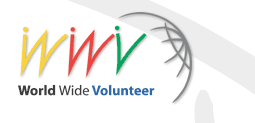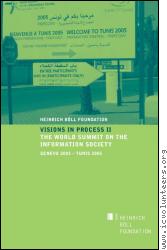A laboratory for new mechanism: Volunteerism as a building block for multi-stakeholder approaches (MSAs)Click to Download visions_in_process_ii.pdf (3.8M) 16 November 2005 © Heinrich Boell Foundation, Visions in Process II, The World Summit on the Information Society, Berlin, Germany IntroductionTo many, the World Summit on the Information Society (WSIS) process has been a laboratory: Its innovative mechanisms hold the potential to serve as effective models to help shape future UN meetings and summits, as well as other processes involving multiple stakeholders. In order to realize this potential, it seems critical to step back and to evaluate the achievements of WSIS, both in terms of its success in attaining its original objectives, and its potential for structural replication elsewhere. While it is premature to draw final conclusions regarding the WSIS process, this article outlines some initial findings on the structure of the meeting and overall success in implementing its recommendations and policies. In the second part of the article, we describe some positive results stemming from the active participation of one specific constituency, the volunteer sector. The volunteer sector first became involved in the process of the WSIS in 2002, at the African Regional Conference in Bamako. Since then, volunteers and volunteer organizations have actively contributed to its preparatory process, the Geneva summit, and the Tunis phase. We conclude that some of the lessons learned in the volunteer sector are particularly relevant to future efforts to build both effective multi-stakeholder relationships and successful partnerships. At the end of this paper, we detail the unique qualifications of volunteers to impact these processes. Contents
WSIS: quick assessment of what worked and what did notWhile there is no substitute for a comprehensive evaluation of WSIS from a multi-stakeholder perspective, some lessons can be drawn on a more limited basis. The following section is an attempt to reflect upon the successes and failures of WSIS from my perspective as a civil society representative, a member of the Civil Society Bureau and focal point for the volunteer constituency. Overall, from a process perspective, the summit can be described as a success. I would stress that this is particularly true for the first phase of WSIS, as momentum was built thanks to excellent leadership by the President of the WSIS Preparatory Committee, H.E. Mr. Adama Samassekou. His leadership was driven by a vision of inclusiveness and cooperation, embracing and building on the MSA, allowing the summit to become more than just a technocratic meeting. The summit had both a strong human dimension, and an understanding that technology alone can by no means solve all the issues at hand. Instead, various actors need to come to the negotiating table and wholeheartedly engage in forging dialogue and innovative recommendations. I believe that this vision and drive to find solutions brought us from what Professor Wolfgang Kleinwächter called "turmoil," to cooperation, or even a certain degree of trust, between governments, civil society and the private sector. True, the process was not perfect. But if we consider it as a first series of baby steps, or as the fledgling attempts of a bird that is learning to fly, initial imperfections can only be considered normal. Inclusion, partnership, and solidarity are key-words which characterize the entire preparatory process of the Geneva phase of the World Summit on the Information Society. The success of Geneva will have been to lay the foundations of this new society ? the society of shared knowledge ? characterized by real partnerships which need to be built and reinforced among the main stakeholders of the information society, a partnership based on a new spirit of cooperation, listening to the Others, and, foremost, based on an active solidarity among States, among peoples and citizens of the world, each being conscious of the interdependency between Actors. Adama Samassékou, President of PrepCom 1 of the WSIS So, from a civil society perspective, what are the lessons that can be learned from the whole process of WSIS? Please note that the list below contains some basic and non-exhaustive observations. Lesson one: The bodies created to organize the participation of civil society helped streamline input. Three main bodies played such a role: 1) the Civil Society Plenary, which brought together all participants; 2) the Working Groups and Caucuses, which focused on specific issues; and 3) the International Civil Society Bureau (CSB), which dealt with procedure. While, in the case of the latter, the mechanisms for establishing the Bureau could be refined and improved, it clearly played a useful role, acting as both a facilitating body and a connector between civil society and other stakeholders. As such, it managed to establish trust with governmental interlocutors, laying the foundations for ongoing dialogue and joint Bureau-to-Bureau meetings during every PrepCom and Intersessional gathering. Lesson two: The opportunity for various sectors to participate as speakers is a good precedent and model. The closing event of the WSIS Geneva summit in December 2003 was the first UN closing session I attended where actors other than governments played such significant roles. This participation provided a uniquely comprehensive overview of all the various initiatives led by different actors and interest groups, which added value to the process. Lesson three: Mechanisms can and must be regularly refined and adapted to changing needs. During its Cape Town meeting in December 2004, for example, the CSB evaluated its functioning and underwent a reform to better meet its goals. Additionally, during this meeting, an open-ended Working Group on Working Methods was launched, looking at the various mechanisms and seeing how these can not only interrelate, but also how they can constantly be refined and improved. This additional think tank was very helpful in drafting, for example, the CSB charter, a document that needs to reflect the essence of the CSB, but is best written with a fresh and outside perspective. What about the challenges the process faced, and things which could be improved in the future? From my perspective, the MSA was not applied as systematically as it could have been in the WSIS process. The Task Force on Financial Mechanisms (TFFM), for example, left civil society and the private sector completely on the outside. The Working Group on Internet Governance (WGIG), in contrast, has been built as a truly multi-stakeholder body. Furthermore, in my experience, there is a great gap between summit discussions and field realities. It seems that international talks actually have only triggered to a minor extent inclusive local-level discussions. The regional conference held in Rio de Janeiro in July 2005 provides a good example of this. As a regional WSIS conference, one might have expected it to be a multi-stakeholder event, involving national and regional constituencies. Additionally, considering the number of NGOs and open source projects in Brazil, one would anticipate substantial participation from various sectors. However, non-governmental participants were scarce, and more marginalized than in any other WSIS-related conference I have ever attended. The badges used to accredit participants were indicative of this approach: orange marked badges were given to "governments", who had access to all sessions. Everybody else, including civil society and private sector participants, had badges with the label "observer". The outcome documents were negotiated behind closed doors, with only government participation. On several occasions, I heard government officials talk on behalf of civil society. All of this seems a bit surprising in a multi-stakeholder environment. There was little or no evidence that local communities had embraced any of the WSIS principles and action lines. African regional conferences were, in my experience, substantially more inclusive of civil society than their Latin American counterparts. In Accra, in February 2005, the presence of numerous private-sector stands indicated at least some degree of interest in the WSIS by this sector. In addition, African civil society has been leading the development of new mechanisms to support its regional participation in WSIS, with the creation of a coordinating body called ACSIS (African Civil Society for Information Society), including experts from various backgrounds, regions and genders. On the other hand, there remains a great deal of work to be done to achieve greater gender balance in official sessions of regional African conferences. Of nine opening speakers of the Accra conference, for instance, only one was female. The picture was only slightly more encouraging in the parallel sessions. This can be explained by the fact that governing bodies in Africa are largely male-dominated. However, if the human dimension of the Information Society, capacity building and knowledge sharing is truly to be addressed, it is important to avoid excluding half the potential implementing force. We therefore need to find mechanisms to make sure women are fully included as part of the driving force for technology development and transfer. Without them, it will be difficult to bridge the digital divide and build a true knowledge society. Regarding the implementation of the documents endorsed at the WSIS Geneva summit, I would have hoped for some clear and major steps during the Tunis phase, encouraging and enabling initiatives such as the bottom-up campaigns launched by the youth caucus and the volunteer family. For post-WSIS, we could perhaps get some inspiration from the International Year of Volunteers (IYV 2001). This event was considered by many as a great, top-down and bottom-up implementation success story, involving millions of people at local, national and international levels. The United Nations Volunteers Programme (UNV) set up a team called Team IYV. This team created basic documents, templates and tools. It then worked with national volunteer organizations, governments, UNV and United Nations Development Programme (UNDP) offices to set up national committees. While all national and regional campaigns used the same basic objectives for the year, individual committees shaped their own structures, set up their own websites and launched their own individual initiatives. By the end of the year, there were 126 national committees: All had prepared their own campaigns, some were government-run, others completely civil society based, while yet others contained a mixture of the two (Report of the International Symposium on Volunteering: www.worldwidevolunteer.org/cdrom). While, in many cases, the committees disintegrated after the year had passed, their work has led to substantial long-term improvements for the countries' volunteer sectors. External linkshttp://www.boell.de/downloads/medien/visions_in_process2.pdf Posted: 2005-11-16 Updated: 2010-1-05 | ||









